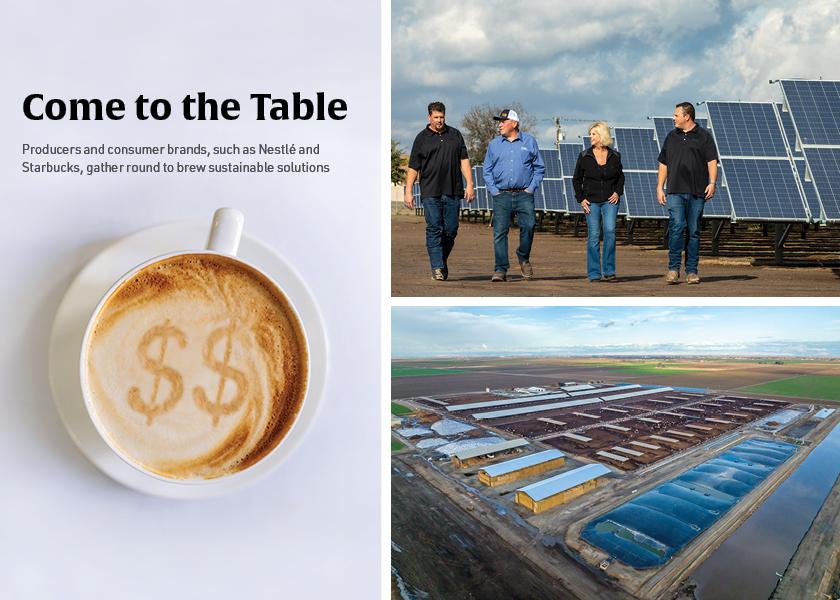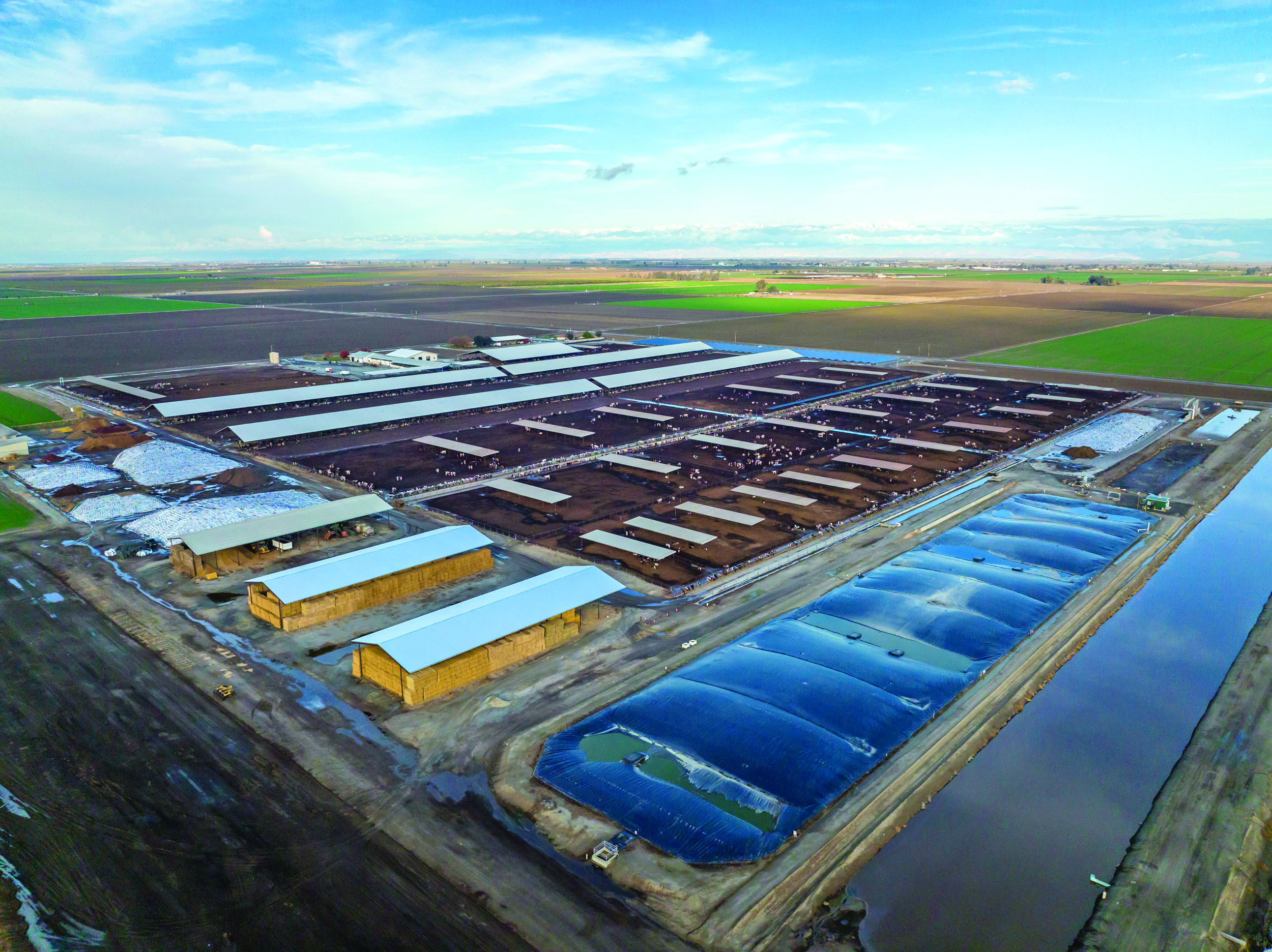Come to the Table

When you wake up in the morning, your first thought is caring for your cattle, land and employees — and maybe that first cup of coffee. Likely the focus is not on sustainability. The buzzword might seem to be just that — a catchphrase. But it’s vital for the dairy industry to make sustainability a priority.
Look to the European Union, and we quickly are reminded the U.S. dairy industry is indeed fortunate to have a voice to help write the narrative on sustainability. Understanding how leading brands, such as Nestlé and Starbucks, are responding to consumer trends and expectations is also important. Not that long ago, the Innovation Center for U.S. Dairy, founded by U.S. dairy farmers, pledged aggressive environmental goals to achieve greenhouse gas neutrality, optimize water usage and improve water quality by 2050.
California dairy producer Arlene VanderEyk spoke at the 20th annual Milk Business Conference, sharing today’s consumer is willing to pay more for a product that meets their environmental values and goals.
“But, [the consumer is] also very skeptical about companies that make claims,” she says. “So, we have to tell our story, and we must get our messages across.”

Honored with a U.S. Dairy Sustainability Award in 2021, VanderEyk and her family have been dairying for four decades and have worked with Calgren Dairy Fuels, LLC and Maas Energy Works Inc., on a project that generates renewable transportation fuel. In addition, the VanderEyk’s installed solar panels in 2015 and just finished installing additional panels this year to offset 65% of the dairy’s energy.
“We are always looking to new avenues to better our dairy,” she says. “We are open to new ideas and new opportunities and understand what works for one dairy, might not work for another.”
Understanding it is an all-hands-in approach, VanderEyk says she and her family have worked closely with their co-op, Dairy Farmers of America, who she says is playing a leading role in helping reduce greenhouse gas emissions for the dairy industry.
“DFA is actively endorsing renewable energy, such as wind power, not only on our farm but also in the plants,” she says. “It is helpful when they bring partners to the table.”
It will take a united approach from the dairy industry to build trust with consumers, VanderEyk says. Leading consumer companies such as Nestlé and Starbucks, are already doing their part to push dairy sustainability forward.
NESTLÉ
Started more than 150 years ago as a dairy company, Emily Johannes, head of diverse and sustainable sourcing for Nestlé USA, says the company’s focus has not changed in terms of how they deliver what consumers want through their iconic brands, such as Carnation, DiGiorno and Stouffer’s.
“We are passionate about what our consumers want, and we are doing the actions necessary in our dairy supply chain to help improve social and environmental conditions for future generations,” Johannes says.
Like the dairy industry, Nestlé has set sustainability targets, and a detailed, time-bound plan to help the company reach net zero by 2050.
“We have interim goals, like 20% greenhouse gas reduction by 2025 and a 50% greenhouse gas reduction by 2030,” she says.
Being transparent, Johannes says Nestlé has shifted its company focus under the Net Zero road map, which has resulted in renewed dedication to work with farmers and make the needed financial investments.
In October 2020, Nestlé became the first of what the dairy community hopes will be many partners joining the Net Zero Initiative, contributing, funding and expertise to help propel the entire industry’s progress toward a more sustainable future. Nestlé brings a wealth of knowledge and industry leadership to the table, and an earnest commitment to supporting U.S. dairy farmers in environmental advancements and technology adoption.
In June 2021, Trinkler Dairy Farm, a supplier to Carnation in Modesto, Calif., became the first dairy to receive grant support from Nestlé. Pilot farms such as this seek to identify, demonstrate and de-risk new sustainable practices and technologies that increase on-farm profitability while reducing greenhouse gases and water use and improving water quality.
STARBUCKS COFFEE COMPANY
Starbucks Coffee Company’s director of sustainable dairy, Angela Anderson, says their environmental goals mirror Nestlé, with a focus on reducing carbon waste by 50% by 2030. Anderson says Starbucks is evaluating how they make opportunities for carbon and water strategies.
“We are trying to build a program we can scale collaboratively,” she says. “I think about the last 20 years and our success in coffee, what we’re building for dairy is very similar.”
In 2020, Starbucks made a commitment to sustainability and continues to accelerate progress in three key areas: environmental stewardship, farmer and worker wellbeing, and quality of the animal.
According to Anderson, “As we think about dairy sustainability, we see it as a big opportunity for our company and look at this industry as part of a solution.”
IN IT TOGETHER
Anderson says Starbucks understands its future is also connected to the future of farmers.
“We know it’s never been more expensive to be in agriculture as a whole,” she says. “We understand we have a responsibility to try to figure out solutions together.”
When it came to working with their coffee farmers, Anderson says they learned the importance of sharing resources through their farmer support center. Additionally, Starbucks has invested $50 million toward coffee farmers to help ensure sustainability practices and is also investing $10 million in the U.S. Dairy Net Zero Initiative.
Purchasing a lot of fluid dairy products, Anderson says Starbucks is passionate about getting more involved with sustainable dairy practices.
“Knowing we can do this for coffee, it is a natural fit to ask how we do that for dairy, too,” Anderson says.
Like Starbucks, Johannes says Nestlé is also not starting from scratch and understands a lot has already happened on dairy farms regarding sustainability.
“We buy a lot of dairy, whether it’s cheese or powders. And because of this kind of level of dairy [purchasing] it really came to the top for us as a company in terms of where do we need to focus,” she says.
Nestlé has invested more than $3 billion globally in their goal to achieve net zero emissions by 2050.
“We’re excited we’re in it together and we’re taking the journey together as opposed to other ways this might have happened,” Johannes says.
BE OPEN TO OPPORTUNITIES
Five years ago, VanderEyk was one of a dozen dairies that partnered with Calgren Renewables Fuels and Maas Energy Works on a cluster of dairy digesters in the Golden State. Today, 19 producers and a total of 65,000 cows are connected by a 22-mile underground pipeline that includes an anaerobic digester at each dairy. VanderEyk encourages other producers to be open to opportunities that come about and lean in and work with companies, such as Starbucks and Nestlé, that are enthusiastic to learn more and partner with dairy. Because of a sustainability focused partnership, the VanderEyks hosted a tour on their farm, which included the person who purchased all the food for Disneyland.
“He was really impressed with how we take care of the cows and how sustainability actually works,” VanderEyk says.
This led to another opportunity to visit with Harley Pasternak, who is a nutrition expert and celebrity trainer. VanderEyk says it was an incredible opportunity and fellow producers must be willing to share their sustainability story.

“We have a lot of support from our checkoff and from our processors to help us do that,” she says.
When your alarm clock goes off and you pull on your bootstraps, realize others are inspired by your efforts. Continue to share your dairy’s story, as the effort and push toward sustainability are being driven further by leading consumer companies. This is ultimately because the consumer cares deeply about how farmers care for their cattle, land and employees, and at the end of the day, your hard day’s work is a big part of the sustainable solution for a better world for tomorrow.







